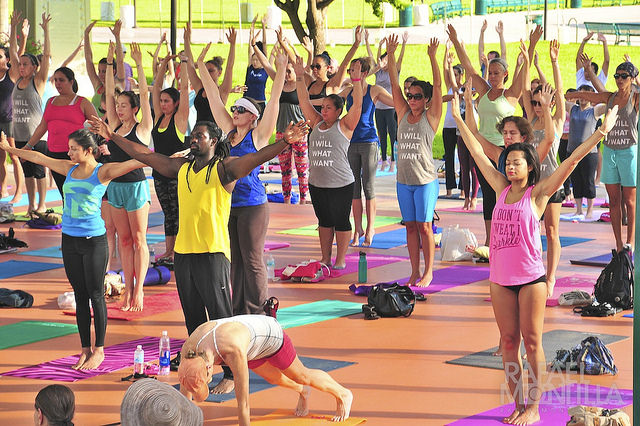
At nearly every social event I attend, I wait for the dreaded question “Hey, do you still do that yoga thing?”
I try my hardest to quell my defensive attitude towards that particular question because it certainly hits a sore spot when your career seems belittled to a hobby that you do in your spare time.
I get it. School teachers, doctors, lawyers, accountants, administrators, the list goes on of the professions where people sort of have an idea of what that professional’s work day is like. On the other hand, a yoga teacher’s workday can be quite chaotic and it’s uncanny the flexibility of escaping the 9 to 5 world can be very misleading as to what it is we as yoga teachers do for a living.
The response to “what do you do for living?” is challenging. The basic answer is I teach yoga, only that response isn’t generally satisfying enough which then leads to assumptions about what I do for a living.
In my response, I would find it highly unlikely to say “I teach yoga” and continue to express “which means that I spend about an hour of the day reading about different yogic philosophies and reflect whether I am currently living this philosophical point to then include in my class planning. Oh yes, there’s class planning—what I do here is develop a theme for the particular class I’m about to write, something authentic that speaks to me and that I can convey in simple, universal terms that could potentially apply to the life of each student seated in front of me…”
I can go on.
So just like I wouldn’t expect a school teacher to whip out their lesson plans or for a budget analyst to take out the latest budget report, somehow I feel like my answer of “I teach yoga for a living” isn’t always enough to satisfy the ears of the person standing in front of me.
Without a doubt, there is a disconnect between what happens in the corporate world and what happens in non-traditional working professions like teaching yoga. I love nearly every aspect of my profession and I’m grateful every day to do what I do.
These common assumptions that I hear can get me down, and I’m guessing this is true for other yoga teachers as well. It’s also frustrating to continuously hear these assumptions and questions about your career without that perfect answer that makes everyone in the room understand exactly what it is you do and respect your decision to have chosen a different path from everyone else in the room.
“You’re so lucky to be able to do yoga all day long.”
Yes, I am lucky, but, I do not do yoga all day long. I yearn to get on my mat and have the luxury of completing a full 90 minute practice to experience lightness or integration, to learn something new about the practice or to challenge myself testing my boundaries with intricate poses.
As a yoga teacher, guess who is teaching at the times when yoga classes are offered? We are. “But you practice yoga when you teach.” Nope. When I get up in front of a room of students, I teach them. I talk to them about how their legs can internally and externally rotate, tell them how to align their body, encourage them to connect with their breath to understand what is happening right now in their body and I take students through a collective journey where they learn about anatomy, philosophy and breath work.
So, no I’m not on my mat doing downward facing dog ignoring what is going on in my students. An alternative to saying you’re so lucky you get to do yoga all day long is to ask “What did you teach in class this week?”
“It must be so easy to teach yoga—I wish I was a yoga teacher!”
When people admire my profession because they think it’s easy, it really rubs me the wrong way. Teaching any subject or activity with precision, clarity, creativity and passion is not easy! Doing it well requires a lot of practice, focus and skill.
When you dread your work meetings because you might have to speak in front of your peers for a few minutes, yoga teachers speak in front of students (maybe five, maybe over 11,000 at events) for 75 straight minutes on average. I also hold the responsibility of teaching a safely aligned class to a group of people while holding a comfortable space for them to practice.
And that’s just when I’m at the studio.
There is a massive amount of preparation for what culminates into a 60 or so minute class—and imagine the prep that goes into a three hour workshop. Yoga teachers create physically and energetically sound sequences for their students which vary depending on individual levels—there’s no such thing as a one-size-fits-all class.
The type of class varies because one day a teacher teaches a restorative class, then a prenatal class, an advanced asana class and ends the week with an introduction to yoga. The styles and the types of students we teach is so vast and simply cannot be contained into the box that is known simply as yoga. So what do these classes consist of? We don’t just teach physical poses. Classes incorporate a fountain of different elements from creative writing for the opening and closing of the class, written exercise to clearly verbally express instruction, researching anatomy and translating it into laymen terms so students understand the science behind what we are teaching and conveying an overall larger philosophical idea. No matter which way you slice it, teaching yoga isn’t equivalent to easy. Ask us instead, “what are you currently reading to prepare for your classes?”
“Oh yeah…everyone is certified to teach yoga.”
If I had a dime for every person in New York City alone who is certified to teach yoga, I would be rolling in the dough. There is some truth to the fact that there are a lot of people who are certified to teach yoga. Yoga teacher training programs are everywhere, and nearly everyone is accepted. There are bare minimum requirements to be accepted into a program and even with that bare minimum, I still know of cases that these requirements have been waived. That frustrates me but that is an inside the yoga world problem.
The aggravating factor in listening to someone say that “everyone” is certified to teach is that it conveys an attitude that what I do doesn’t require much out of me and that anyone can do what I do. Number 1, please refer back to teaching yoga is easy. Number 2, just because everyone is certified to teach, it doesn’t mean that we are all the same and that our purpose for taking teacher training was the same.
There are numerous certified teachers who teach yoga on the side, with a regular class or two and pick up the occasional subbing gig. There are other interested yoga students who took the training to simply dive deeper into the study of yoga as a personal endeavor. Some people thought teaching yoga would make them millions and now have different employment outside of the field of yoga. There are so many shades in between.
Then comes the grey area that can be difficult to navigate. There are yoga students who complete teacher training and go off to become full-fledged yoga teachers. Just like in any profession, you have the teachers who are just starting to get their feet wet, teaching classes here and there and practicing new skills that they are picking up from their practice or workshops to teach to the masses.
So of course there are going to be mistakes and some inconsistencies, but that is necessary for anyone diving into a new career—just because a teacher is less experienced, it doesn’t make them less of a teacher!
Then you have the more experienced yoga teachers with 20+ years under their belt and just like any other veteran in their professional field that consistency and experience should say a lot about them and the work they do.
It’s not a trend. It’s not a hobby. It’s a career.
And I’m going to throw it out there. Yoga in general is 5,000+ years old which means that there is an incredible amount of research, scholars and teachers who have been in this field for thousands of years passing along this information and expanding upon it. That’s pretty awesome being connected to a field that is so rich in history compared to other professions that are a few years old. Teaching yoga is much more than the certificate one receives at the end of a training. If you are interested in our path and want to spare a yogi of feeling un-special go with “what was your experience like during teacher training?”
“Do you ever do naked yoga?”
To the administrators, CEOs, bankers, professional football players, salesman, and so forth: do you do business naked?
If you think that’s strange, imagine being on the other end of that question—a lot. Yes, naked yoga is a thing. I don’t know anything about it except that it exists. But really? Is it necessary to ask a yoga teacher if they have done or if they teach naked yoga? Although it is a valid question, please do not assume that we yogi teachers are stripping down to our birthday suits. We quite like our stylish yogi clothes from our ambassador companies. Yes, sometimes we get free stuff—another perk of the job.
Please ask us about our clothes not what’s underneath them.
“When are you going to open up your own studio?”
This is the big question—and it’s completely valid. But the assumption is that in order to make “real” money, to be “legit,” you need to own your own business, is false.
This one is a bit wonky for us teachers. Some of us certainly do open up studios, most of us work for those studios and some of us vaguely run a studio out of our home where the focus is more on teaching rather than actually running a business. To run a studio, you have to run a business, which means teaching gets pushed aside. Many teachers want to teach, not run a business.
As a traveling yoga teacher, I’ve seen so many yoga studios bite the dust and for every thriving, well run yoga studio there are countless studios that have closed their doors. As a friend of a yoga teacher, ask us about what we want to do in our career in the next five years, where we see ourself going rather than assuming that the money is in owning a business and that’s what we are dying to do.
We’re not.
As yoga teachers, we strive to break down barriers and communicate to all of our students. We understand that we need different techniques to say the same thing five different ways so that we can reach as many students as possible with our message.
Most yoga teachers will face some if not all of these assumptions at one point or another. It’s important to teach our non-yoga-sensitive friends what we do, what inspires us and why we continue to get up every morning to practice and teach.
We may not be making the Fortune 500 list, but I for one am A-okay with that, because I love what I do.
Author: Allison Schleck
Editor: Renée Picard
Image: Rafael Montilla/Flickr










Read 0 comments and reply